|
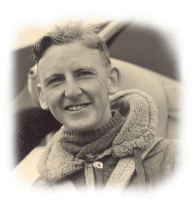 The disappearance of the “Star Ariel” in January 1949 is one of the most famous cases in the Bermuda Triangle and, indeed, one of the most baffling in the history of aviation. This web page is the biography of Star Ariel’s captain and pilot, J.C. McPhee. The disappearance of the “Star Ariel” in January 1949 is one of the most famous cases in the Bermuda Triangle and, indeed, one of the most baffling in the history of aviation. This web page is the biography of Star Ariel’s captain and pilot, J.C. McPhee.
If you have read the books on the Triangle, you are familiar with McPhee’s last transmission and the sudden mystery into which he and his airliner were then plunged. But until now no one has really known anything about the pilot himself. This web page is made possible by the work of his sister, Joan Beckett. She has kindly given this author pictures, documents, even copies of a personal letter and video of John playing golf on Bermuda. Through this web page you will see the character of an expert pilot emerge, a brother, a peaceful spirit and a reflective man. 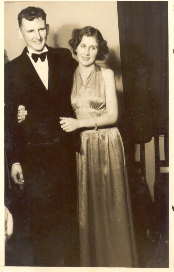
John was born on June 21, 1918, in New Zealand, of Irish/Danish heritage. He was christened “Clutha” after a respected friend of the family, Sir Clutha McKenzie, who founded the Blind Institute and was himself blind. His early life passed as any other. He was educated at the Otago’s Boys’ High School and Victoria University College. Afterward he went on to become a member of the staff of an importers in Wellington. John was an intellectual spirit, though he tempered this with practicality and adventure. His hobbies included yachting, tennis, tramping and golfing. It seemed natural that he would decide to enlist in the RNZAF in 1942.
John, on his 21st birthday, with sister, Joan. It was Joan’s generosity which led to this web page. Courtesy of Joan Beckett.
He quickly showed an aptitude for flying. He had a mature bearing, was charming and considered quite popular by the ladies. Since the hottest action of the war was over Europe and Britain, John was one of many members of the Royal New Zealand Air Force who were sent to Canada for training. After he graduated, he was transferred to England as a pilot of a Liberator bomber. His duty was to fly missions over Germany and France. He was then transferred to India for Lord Mountbatten’s Burma Campaign. One target was Amarapura, which straddled the Japanese supply lines and retreat route from Mandalay. The heavy bombing runs on January 25, 1945, were pulled off neatly, and John was naturally called upon to be interviewed by his hometown newspaper in New Zealand. “Fendalton Man in Big Bombing Raid” read the headlines. John, then a Warrant-Officer, gave the typical general view of the raid for the civilian audience. He described the sight of 3 fires with smoke rising 4000 feet into the air. “The first squadron to go in had done a good job, for fires were burning in the target area when we arrived.”
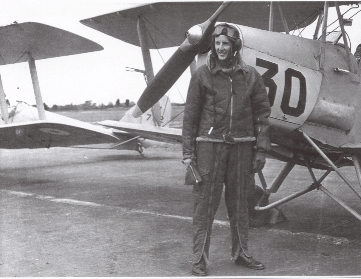 John was transferred back to England and attached to the RAF for a while, and at war’s end this placed him in contact with the best airlines. A peacetime trade at a desk no longer seemed enough for him. He wanted to keep flying. When the war ended John was a Flight Lieutenant. He quickly attained civil flying licenses and found a job with B.O.A.C (British Overseas Airways Corp). John was transferred back to England and attached to the RAF for a while, and at war’s end this placed him in contact with the best airlines. A peacetime trade at a desk no longer seemed enough for him. He wanted to keep flying. When the war ended John was a Flight Lieutenant. He quickly attained civil flying licenses and found a job with B.O.A.C (British Overseas Airways Corp).
John, in training in Canada. He wanted to be a fighter pilot, but was too tall so he was trained in bombers. John would later go on to be the first pilot to mid-air refuel over the Atlantic. Below, his war medals: left to right: 1939-45 Star; Burma Star; Defense Medal; War Service Medal 1939-45; NZ War Service Medal. 
Early in 1947, however, better prospects surfaced. A new company B.S.A.A.C (British South American Airlines Corp) was formed, made up mostly of former RAF pilots. Amidst many old acquaintances and friends, John found himself flying regularly and on long routes. In February he again landed in the newspaper for having been the co-pilot on the world record setting flight from London to New Zealand on February 4, 1947, carrying Air Vice Marshal D.T.C. Bennett.
The flight had been a triumph for BSAAC which as a new company had been playing second fiddle to BOAC. The flight, from London, the Mediterranean, Lydda, Karachi, Calcutta, Singapore, Darwin and Sidney, was a charter that BOAC was unable to accept, but BSAAC accepted it and with record breaking speed. But BSAAC was often run on a shoestring. As the newspaper article put it: “The plane would have to leave on its return flight almost immediately, as it was engaged in the London-Buenos Aires Service.”
This flight attracted more press to BSAAC, and more possibilities. But for now the airline continued to live up to its name and command the British to South America airways.
The new Tudor IV aircraft was also an added boon, so it seemed. BSAAC had been flying mostly converted York transports and Lancaster bombers. But the Tudor was a new, sleek, specially designed airliner. The airline bought a number of them, and had even played a role in their development.
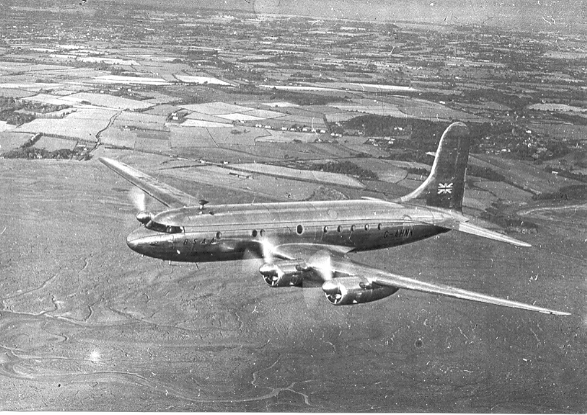
Beautiful shot of a Tudor IV in BSAAC livery, from J.C. McPhee’s personal collection. Courtesy of Joan Beckett.
John McPhee would graduate to full captain soon and get to fly the new Tudors. Although the pace was quick on the small airlines, its limited routes between Britain and South America made its pilots intimately familiar with the weather and idiosyncrasies of the run. The stopovers, though short, were also in some very plush spots, namely Bermuda.
Bermuda came to be a major stopover for any BSAAC flight, since for one it was the only spot of land after the Azores on the who route until one came to Nassau and Kingston. Ferry flights to America for BOAC would often go to Canada and then down to the US, but it was not uncommon to see many BSAAC aircraft dotting the airfields of Nassau, Bermuda, Kingston, and the Azores.
The Tudor IV was distinguishing itself as a beautiful plane, and BSAAC’s livery was a bland but attractive chrome silver, with streaking red lines, and the British union jack mounted on the tail rudder. However, it was also extensively used as a transport, and had distinguished itself in the Berlin airlifts in 1948.
During his Bermuda stopovers, John found time to do a little golf, enjoy the isolated island, and gather with all the pilot types at the White Horse Tavern in St. Georges. By 1949, he was just turning 31 years old. He had been a bomber pilot and civilian pilot and now wore the 4 stripes of an airliner captain. He lived a quiet enough life in Middlesex, England, and as a single, handsome man, was sociable enough but had still not found his mate. Both the writings of his sister and his own show them to be tasteful, unassuming and self-disciplined people.
On January 9, 1949, he would pen this letter.
Dear Sister,
Many thanks for the amusing book you sent me. That fellow Smith is quite a satirist—but I don’t think he can make up his mind whether he is one of “us” or still a visitor.
Looking back on things— particularly the “scrum” *between 5 and 6, to say nothing of the discreet withdrawal to the “lounge” after 6 p.m., I cannot imagine what pleasure is derived from pub drinking.
English pub life is quite [a] wonderful thing and there is little abuse of drinking. We all have our favorite local and what better than to pop in for a pint at your leisure during the evening?
In fact, having written your letter, I shall probably take a walk down to the “Berkely Arms” and have one drink, maybe two, but no more; say hello to the local types and walk back.
A pleasant and convivial way to pass an hour.
I hate this mass production drinking.
New Years Eve I went to a jolly party which saw the light of New Year’s Day. In fact the neighbors had a good view of me arriving home well after breakfast complete with bow-tie, etc.
You possibly heard that our Chief Executive was drowned in Rio. We are not having a new one. Everyone gets a bump higher and the Chairman becomes managing director as well.
Have not seen a show for a while, but the annual G & S season starts soon. Incidentally, I hope NZ puts up a show at cricket next season or I shall be forced to retire to the country during their visit here.
Love to all,
John
*Joan clarifies some of the words in the letter— “re “scrums” — a rugby football term in reality. New Zealand pre-war for some reason had restricted liquor laws and bars closed at 6 pm. The “scrum” was the rush to drink as much as possible prior to closing. Quite barbaric in reality. It is not like that now. Very few women frequented bars in those far off days.”
This letter, mailed on January 10, would not be the next time she heard of John.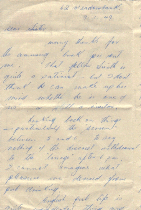 On January 17, John piloted the Star Ariel from Bermuda to Kingston, with 19 persons aboard, including himself. That very day, Joan and her family heard a radio broadcast that it was missing. “We learned more the following day from a newspaper reporter and then spent an anxious time waiting for further news of the ’plane’s fate— it was some days before we learned there was no trace of Star Ariel.” On January 17, John piloted the Star Ariel from Bermuda to Kingston, with 19 persons aboard, including himself. That very day, Joan and her family heard a radio broadcast that it was missing. “We learned more the following day from a newspaper reporter and then spent an anxious time waiting for further news of the ’plane’s fate— it was some days before we learned there was no trace of Star Ariel.”
With all hope given up, the family finally posted the obit in the paper.
What really did happen to Star Ariel? The search had been massive, including 2 US fleet carriers, Kearsage and Leyte, five other naval vessels and 63 aircraft. Nothing was ever found.
There had never been an SOS or inkling of trouble. The last the world had heard from John McPhee was a dull and routine position report.
In 1951 Joan heard from a friend, John Veale, former RNZAF (later to become Pres. Air New Zealand), who had visited Bermuda recently, and met some of John’s old “flyer type” friends at the White Horse Tavern.
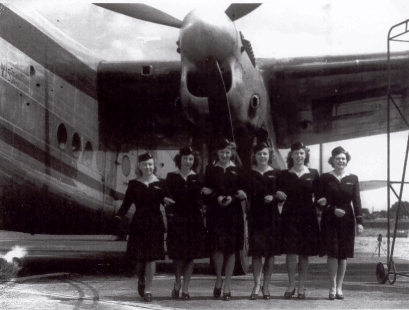
“Star Girls”—stewardesses for BSAAC. Although the names are unknown, one might be J.B. Moxon, the stewardess on Star Ariel. This is from John’s personal effects sent back home. Courtesy of Joan Beckett.
“Both Arthur Woodman and Kippenberger remember your brother very, very well, and we talked about him at some length. If it is any comfort to you Kippenberger told me that the search for the Star Ariel was the biggest search that he had even seen either during the war or after it, he himself being a very active participant. Apparently everything was flying in an endevour to find the missing Tudor, and from what I learned no stone was left unturned. . .”
By the 1970s the Star Ariel was one of many listed as missing in the notorious “Bermuda Triangle.” No one was too interested in anything but the general points of the flight and how it fit with other incidents. Certainly no one was heard details about the persons on board. Perhaps this is why the incident was easy to dismiss when the profitable repast of debunking soon came into vogue. Star Ariel, along with so many others, was finally written down to mundane pilot error or weather or, as in Larry Kusche’s hallmark of debunking The Bermuda Triangle Mystery—Solved, on an ineffective and tardy search.
But for the families, friends, and for those who searched and knew the area, the questions were not so easily answered.
In 1998 Joan’s daughter, Gini, placed an add in Flight International, at the suggestion of the Department of Transport which could no longer answer any of the family’s questions. In it she asked for information from anyone of the relatives of the lost crew and passengers.
In reply to this advertisement, there came one interesting letter. This was from an aviation engineer, Charles Martins, who had worked under Freddie Laker in the 1950s in an attempt to bring the Tudor IV back to usable flying status. He was assigned to see if the Tudor could be used for carrying cargo. His job entailed cutting a cargo door into one derelict Tudor to see if it was feasible. When cutting through the fuselage, he had a chance to examine the inner construction of the Tudor. As far as he could tell the Tudor was “prone to explosive decompression due to metal fatigue.” He came to the firm opinion that this was the cause of both Tudors’ loss.
Although we can never be sure, his theory is worth considering. He was able to bring back the Tudor IV as a cargo carrying aircraft, this time limited to lower altitude and therefore with no need for an hermetically sealed cabin and potential 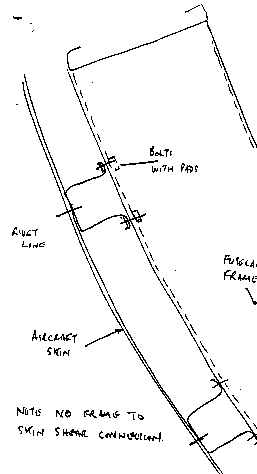 decompression if the seal was broken. As he notes, the Tudor IV went on as the “Super Trader” to carry cargo all around the world without any more mysteries befalling it. decompression if the seal was broken. As he notes, the Tudor IV went on as the “Super Trader” to carry cargo all around the world without any more mysteries befalling it.
Martins’ sketch of the skin to fuselage connection (side view), revealing what he believed to be the weakness and cause of the Tudors’ sudden disappearances.
Nevertheless, there are certain points which still link the Tudors to mystery and argue against Martins’ theory. One, Tudors had been flying all over the world for BSAAC. None disappeared but “Star Tiger” and “Star Ariel.” Moreover, when the Star Tiger was lost, it was at an altitude of only 2,000 feet, making decompression irrelevant. Like Star Ariel it was also a new plane, with only 500 hours flying time. The possibility of metal fatigue is not ruled out, but it seems less likely. True, Star Ariel was at a high altitude when lost, but if it exploded there should have been some of debris located. Yet there was none. There was none from either aircraft.
Martins, as have many others, brought up the loss of the 2 British Comet jetliners in the 1950s as an example of what metal fatigue can do. Both were suddenly lost. In their cases, however, both wrecks were eventually found (in the Mediterranean and in India), and the problem that caused their crashes discovered. These problems were corrected and the model placed back in service. The Tudors were investigated, but no problem was discovered. They were merely relegated to sit on the tarmac for fear there was some problem.
I am also privy to yet another rumor. The first Civil Air Director for Bermuda, Wing Commander M.O. Ware, though in ailing health, recalls that an engineer was sent out from London to do tests on Tudors sitting idle on the field at Bermuda. His tests showed that fuel in some had a tendency to accumulate in the engine farings, creating a potentially dangerous and explosive situation. Due to his ill health, however, he has been unable to locate his diary and confirm the engineer’s name and whether it was indeed the Tudor aircraft in question.
All this aside, we are left with mystery to this day. It seems far more than coincidental that out of all the routes the Tudors flew, the only two to vanish were in the Triangle, each without trace.
|
